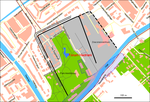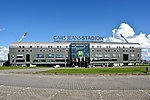Hofwijck
Architecture of the NetherlandsBiographical museums in the NetherlandsBuildings of the Dutch Golden AgeHistoric house museums in the NetherlandsLeidschendam-Voorburg ... and 2 more
Monuments and memorials in the NetherlandsMuseums in South Holland

Hofwijck (Dutch pronunciation: [ˈɦɔfʋɛik]; or Vitaulium in Latin) is a mansion built for 17th-century politician Constantijn Huygens. It is located in Voorburg on the Vliet canal from The Hague to Leiden. Formal address of the cultural heritage is 2 Westeinde, Voorburg, the Netherlands, but its location today is better known as the Voorburg railway station.
Excerpt from the Wikipedia article Hofwijck (License: CC BY-SA 3.0, Authors, Images).Hofwijck
Westvlietweg, The Hague Leidschenveen-Ypenburg
Geographical coordinates (GPS) Address Website External links Nearby Places Show on map
Geographical coordinates (GPS)
| Latitude | Longitude |
|---|---|
| N 52.065 ° | E 4.3619444444444 ° |
Address
Tuin van Hofwijck
Westvlietweg
2495 AB The Hague, Leidschenveen-Ypenburg
South Holland, Netherlands
Open on Google Maps







